Kollyva, also spelled kolyva, koliva or colivă, is a sweet dish prepared with boiled wheat berries, nuts, raisins, pomegranate and spices, which is taken to church to commemorate our deceased during funerals or memorials.
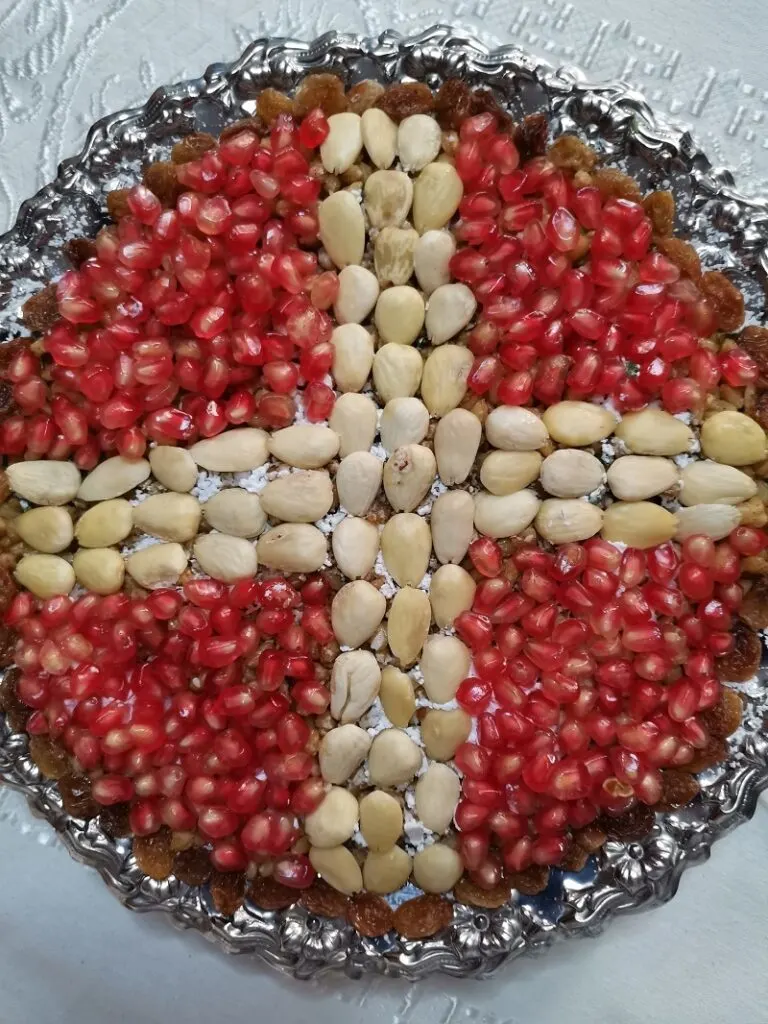
In the Ancient Greek panspermia, a mixture of cooked seeds and nuts were offered during the festival of the Anthesteria.
The association between death and life, between that which is planted in the ground and that which emerges, is deeply embedded in the making and eating of kollyva.
The ritual food passed from paganism to early Christianity in Byzantium and later spread to the entire Orthodox world.
The day before the Mnemosyno, (memorial) we prepare kollyva. The “Kollyva” is made of boiled wheat grains.
Boiled wheat is used as a symbol of the resurrection of everyone at the Second Coming of Christ.
Wheat-based foods, usually sweetened, are highly symbolic of rebirth and regeneration and thus have always been associated with the foods served in honour of the dead.
Let’s not forget the word “macaroni” which comes from the Greek words “makaria” (meaning food made from barley”) or “blessed” and “aeonia or “eternal” and were offered in ancient Greece after funerals.
The word “kollyva” also stems from the Ancient Greek word κόλλυβο (kollyvo pr. koh-lee-voh) , which originally meant cereal grain.
Note:
On the day of the funeral, the family makes kollyva (just boiled wheat) which is placed in a plate.
After the Trisagion, when the casket with the body is lowered in the tomb, the priest breaks this plate over the coffin and throws it in the grave together with the kollyva.
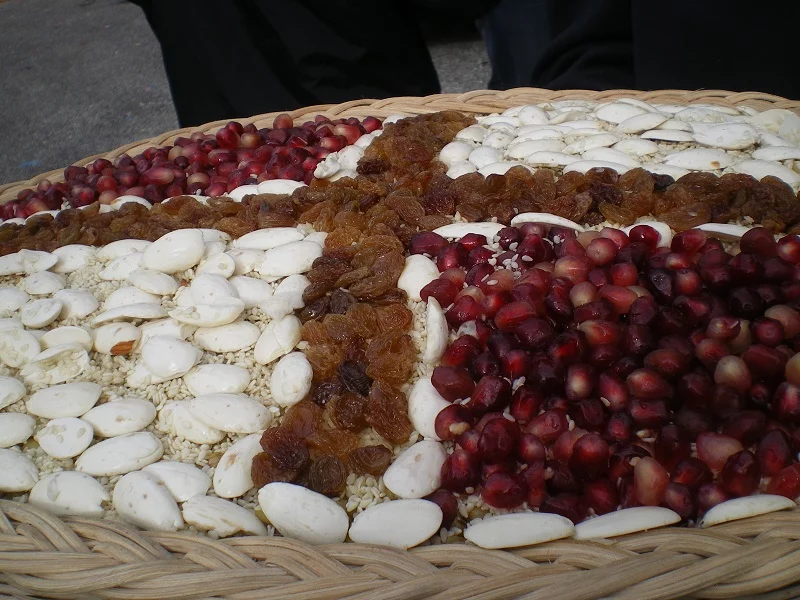
What is a Mnemosyno
Mnemosyno (pl. mnemosyna), in Greek “Μνημόσυνο” (pronounced mnee MOH see noh) is a special service, a memorial, held in the Orthodox Church for the repose of the souls of the dead.
Origin of the word
Mnemosyne in Greek: Μνημοσύνη, pronounced [mneeːmoh SEEːnee]) is the goddess of memory in Greek mythology. She was one of the titanesses and was the daughter of Uranus and Gaia.
“Mnemosyne” is derived from the same source as the word mnemonic, that being the Greek word mnēmē, which means “remembrance, memory”.
Mnemosyne was the daughter of Zeus and the mother of the nine Muses.
What is aTrisagion
The “Trisagion Service” is a brief service that is chanted and performed by the priest for a person who has died.
With out memories we embrace those we cannot embrace with our hands..
The service is often performed at the following times:
• Just after the person has died, in the home or hospital.
• On the evening before the Funeral service, either in the funeral home or in the Church.
• On the day of the Funeral. The day of the funeral will depend when a place is found in the cemetery. During the burial, if it takes place before the third day, the Funeral service takes place inside the church and then a Trisagion follows, just before the coffin is lowered into the grave.
• On the third day. (This day usually falls on the night before a funeral service or on the funeral day, in which case, the service is already performed).
• On the ninth day and on the fortieth day.
The Trisagion service always takes place at the cemetery.
When are mnenosyna held
Mnemosyna (memorial services) always take place in the church following the divine liturgy.
The special day for the bereaved is held on Saturdays. Saturdays are dedicated to our deceased and therefore, the memorial service should be held on a Saturday and not on Sundays.
Although Mnemosyna do take place on Sundays, this is wrong because Sundays are dedicated to the Resurrection.
The first Mnemosyno takes place after forty days.
On the fortieth day, the soul will be judged by God, as to where it will remain. The purpose of this memorial, is for the relatives and friends to pray to God and request that the soul of the departed will remain in Paradise.
Thereafter a mnenosyno is held after three months, six months, nine months, and after one year.
On the third year if the family does not own a tomb, the body is exhumed. The bones are washed and placed in boxes, which are saved in the cemetery.
Thereafter, a mnemosyno is held annually on the Saturday preceding the anniversary of the date of death of the deceased.
Psychosavato
Psychosavato (pl. psychsavata). means “Saturdays of the souls” or “Soul Saturdays”.
There are two Saturdays designated by the Greek Orthodox Church for the commemoration of those who have departed.
These days do not fall on the same day every year as this will depend when Easter falls.
The first one takes place 57 days before Easter.
The first Psychosavato takes place during the Carnival, two days after Tsiknopempti (Smelly Thursday, Charred Thursday, or Smoky Thursday) or before Meatfare Sunday.
The Second Psychosavato is the Saturday before Pentecost i.e. seven weeks after Easter Sunday: that is to say, the fiftieth day after Easter inclusive of Easter Sunday.
The two Psychosavata are honored by the faithful with memorials in the churches, trisagion on the graves of their beloved ones, sharing of kollyva and charity to the poor called (“psychiko”).
Dates to remember
My post coincides with PsychoSavvato (Saturdays of the Soul).
The dates are not the same every year but the Saturday of the Souls are celebrated on the Two Saturdays before Lent begins: the First Saturday of Lent and the Saturday before Pentecost.
The third is celebrated on the day of St. Theodore’s miracle.
On PsychoSavvato a special service takes place in church where kollyva are taken for the resting of the souls of our deceased.
06/03/2021: 1st Psychosavvato – 02/05/2021: Holy Easter – 19/06/2021: 2nd Psychosavvato
26/02/2022: 1st Psychosavvato – 24/04/2022: Holy Easter – 11/06/2022: 2nd Psychosavvato
18/02/2023: 1st Psychosavvato – 16/04/2023: Holy Easter – 03/06/2023: 2nd Psychosavvato
Are there more Psychosavvata?
However, apart from the official psychosavata, in some areas there are other Saturdays that are dedicated to the memory of the deceased, such as the Saturday before the feast of St. Dimitrios in Thessaloniki.
Also, in Athens there are two more psychosavata. The Saturday of Tyrini (Cheesefare) and the Saturday of the first week of Lent, which is also known as Saint Theodores’ Psychosavato.
The Psychosavato of St. Theodores’ is again a mobile holiday and is celebrated on the Saturday of the first week of Lent.
In John 12:24, Jesus says: “Very truly, I tell you, unless a grain of wheat falls into the earth and dies, it remains just a single grain; but if it dies, it bears much fruit.”
The boiled wheat is used in the Orthodox Church as a symbol of our hope in the Resurrection.
From the grain that died comes the fruit of eternal life.
Why, then, do we call the wheat ‘kollyva’?
This name comes from a term commonly used during the fourth century, particularly where the following miracle occurred.
The Emperor Julian the Apostate tried to have the fruits and vegetables, for use by Christians who were fasting during Great Lent, contaminated!
In a dream, Saint Theodore the Tyron appeared to Patriarch Evdoxios and told him to instruct the faithful to consume only boiled wheat (‘kolyva’).
The faithful responded accordingly and were able to continue the fast! This miracle is commemorated annually on the third Saturday of Souls.
How to make Kollyva
To make kollyva, boil the wheat from the previous day until it is soft (it is ready when it cracks).
The cooked wheat berries are drained and left in a colander to dry overnight. Alternatively, you can spread them on a clean kitchen towel and cover them with another one, so that all the moisture is absorbed.
Soak the almonds in water for a few hours and blanche peel them. You can speed up the procedure by bringing them to a soft boil, adding cold water and peeling them. However, if boiled they tend to get a slightly darker colour.
Peel the pomegranates and keep them in the fridge.
Clean the raisins from any leftover small stems.
Toast the sesame seeds until lightly golden and fragrant.
Assembling the Kollyva
The following morning, before going to church, put the wheat berries in a bowl and add some of any of the following ingredients:
- Dried nuts, such as almonds, walnuts, hazelnuts or pine nuts
- Raisins
- Pomegranate seeds
- Spices, such as ground cinnamon, anise seeds or cumin
- Finely chopped fresh parsley, fresh cilantro (coriander) or fresh mint, depending on the area
- Dried breadcrumbs or koudames (peeled and roasted chickpeas) or vegan cookies
- Roasted sesame seeds
- White or silver edible dragées
All of the above ingredients, including the wheat berries are symbolic.
Decorating Kollyva
After mixing all these ingredients well, they are then placed on a tray and a thin layer of icing sugar is added on top to cover the mixture.
Usually kollyva are decorated with blanched almonds, raisins and pomegranate arils. If pomegranate are not in season, you can leave it out.
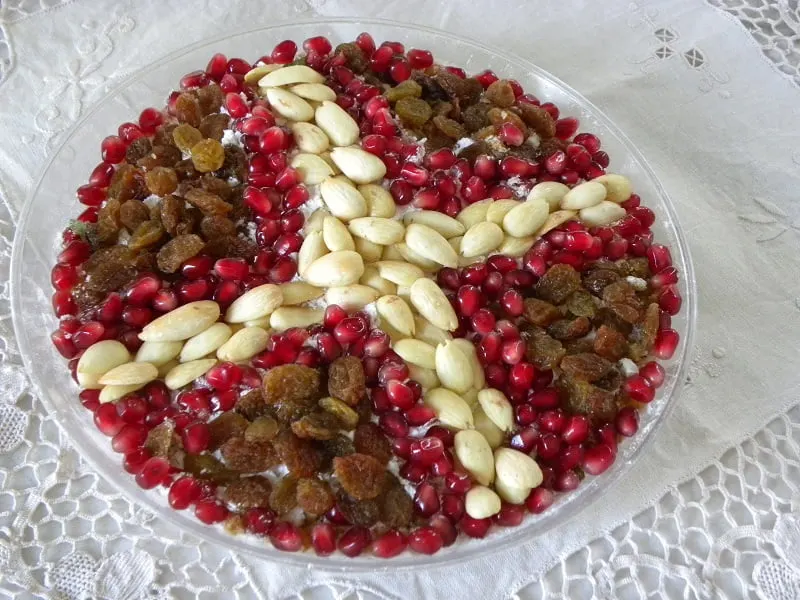
If you like you, instead of the above three ingredients, a thick layer of icing sugar is added on top of the mixture and are decorated with the white or silver edible dragees.
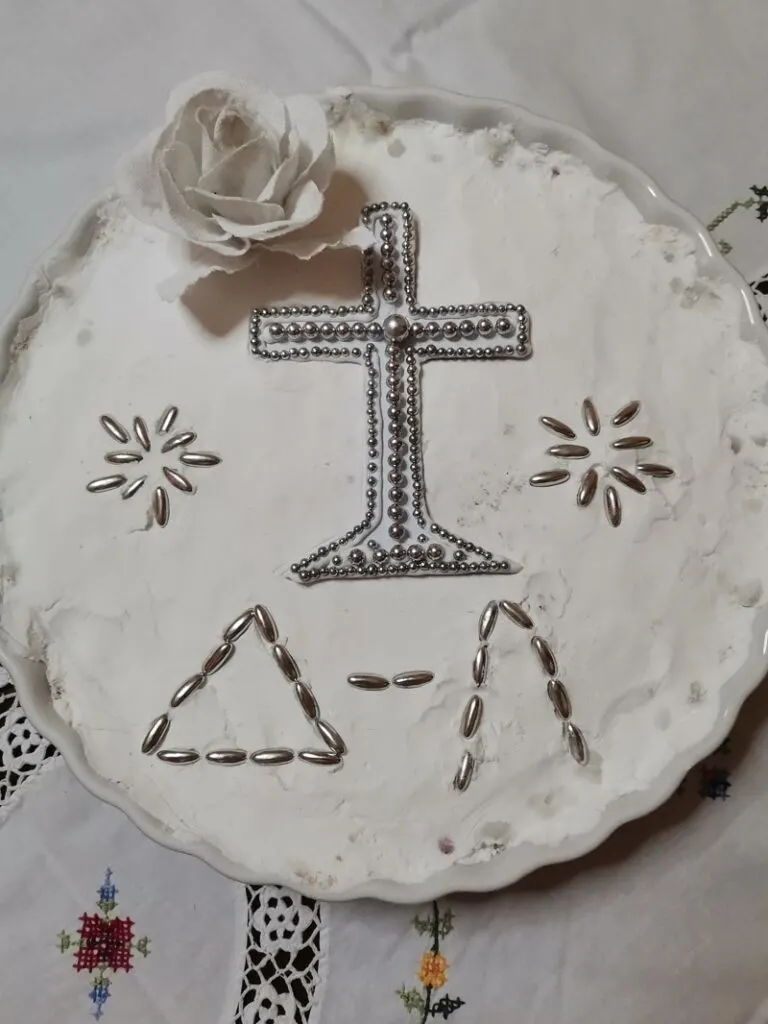
After the mnymosyno service is over, people gather outside the church, all the ingredients of the kollyva are mixed well together and offered to the people in small paper bags or paper cups and a spoon.
The people attending in their turn will say “May God rest his/her soul”.
Kollyva is also a wonderful dessert
Apart from the religious, ritual background behind this food, this is really something which you should try.
In my cookbook Mint, Cinnamon & Blossom Water, Flavours of Cyprus, Kopiaste as well as in Volume 2 of the e-cookbook, it is listed under desserts because it is sweet and very delicious and it is such a pity we only make this during such unpleasant occasions.
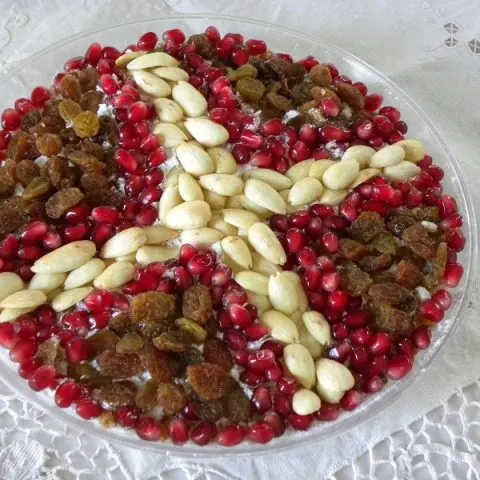
Kollyva (Greek Memorial Food)
Kollyva, is a sweet dish prepared with boiled wheat berries, nuts, raisins, pomegranate and spices, which is taken to church to commemorate our deceased during funerals or memorials
Ingredients
- 1 kilo wheat berries
- 1 - 2 bay leaves
- 300 grams roasted white sesame seeds
- 1 cup powdered vegan biscuits or cookies
- 100 grams icing sugar
- 1 tsp ground anise seeds
- 1 tsp cinnamon
- 1 tsp ground coriander seeds
- 4 tbsp fresh parsley, finely chopped
To decorate:
- 2 tbsp icing sugar
- 300 grams sultana raisins
- 500 grams blanched almonds
- The seeds of 1 or more pomegranates
Instructions
- Prepare all your ingredients from the previous day: Soak the almonds in water for a whole day so that they can be peeled easily and retain their white colour (If they are boiled and then peeled they are not so white) After peeling them, put them on kitchen paper to drain. Peel the pomegranate seeds, roast the sesame seeds and clean the raisins from any leftover stems. Prepare a stencil with a cross to fit the size of your platter or tray.
- Clean and wash the wheat and leave it to soak in water for at least 2 - 3 hours. Then boil the wheat and skim off the froth forming on top.
- Add the bay leaves and cook the wheat berries until they are soft, about 30 minutes.
- Place it in cold water and then drain. Discard the bay leaves.
- Spread it on a clean kitchen cloth napkin and cover it with another one, so that all the moisture is absorbed. Alternatively, we can put it in a colander and leave there overnight to drain.
- In the morning put the cookies or any of the other alternative ingredients in the food processor together with the spices and mix until they are powdered.
- Put the wheat in a bowl, add the powdered cookies, the parsley as well as some almonds, pomegranate and raisins and mix well.
- Put the mixture on the platter or tray and sieve the icing sugar on top.
- Put the stencil with the cross in the middle of the platter. Fill the four sides with two of the three ingredients, either with the almonds, pomegranate or raisins. Remove the stencil and fill the cross with the third ingredient.
- After the memorial, mix all the ingredients well, before offering them to the people attending the memorial.
Notes
You can use the almonds, raisins and pomegranate seeds to decorate the kollyva as you please. Make the cross with one of these ingredients and decorate the four sides with the other.
Nutrition Information
Yield 50 Serving Size 1Amount Per Serving Calories 135Total Fat 7gSaturated Fat 1gTrans Fat 0gUnsaturated Fat 6gCholesterol 0mgSodium 80mgCarbohydrates 17gFiber 2gSugar 8gProtein 4g
"These values are automatically calculated and offered for guidance only. Their accuracy is not guaranteed."
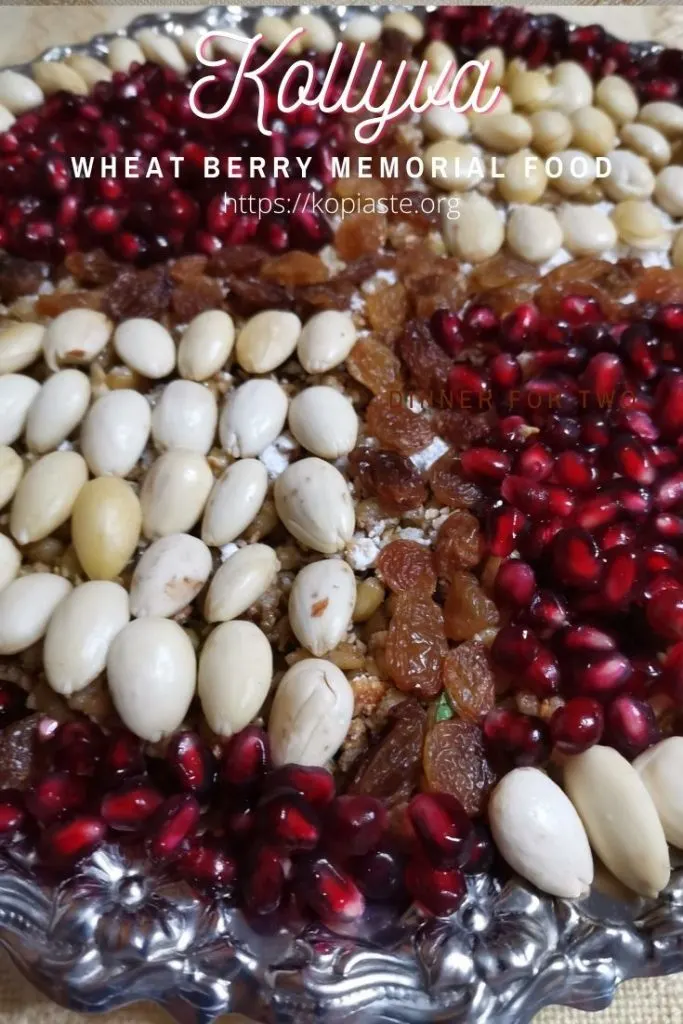
Kopiaste and Kali Orexi!


Jannet
Tuesday 14th of March 2017
I just love reading about different traditions from different beliefs. It is remarkable how much effort people will put into the death and memorial of a loved one. Let us not forget those who were so dear to us.
Thank you!
Nautus
Saturday 25th of May 2013
Just a note, kolliva comes from the ancient Greek kollybo which was part of the ancient Greek ritual of offering the mixture of seeds/grain/barley/dried fruit during the funeral. It predates Christianity.
Ivy
Saturday 25th of May 2013
Thank you for your comment. I agree with you that a lot of Christian traditions come from ancient Greece, this one originating from panspermia and pankarpia.
Diana
Wednesday 29th of April 2009
I am a romanian. We are also greek orthodox, even there are a lot of things different from Cyprus church related traditions. When I tasted for the first time this version of kolyva(coliva in our language) I though it was disgusting (and I still think it is). I mean no offence, but is so different then romanian version. Ours you can eat like a sweet after dinner, is that good. Our recipe is with whole wheat, walnuts, biscuits, candies, sugar or honey, no other seeds are added. I am really intrigued, is the greek version different then these also?
giz
Sunday 22nd of February 2009
I learned alot from this post. I find most interesting all the symbolism embedded with each date and ingredient. Although this must have been a difficult post for you to create, you certainly did help the rest of us understand things a little more.
Joan Nova
Saturday 21st of February 2009
Interesting folklore. Thanks for sharing it. Very similar to a Syrian dish I'm familiar with.